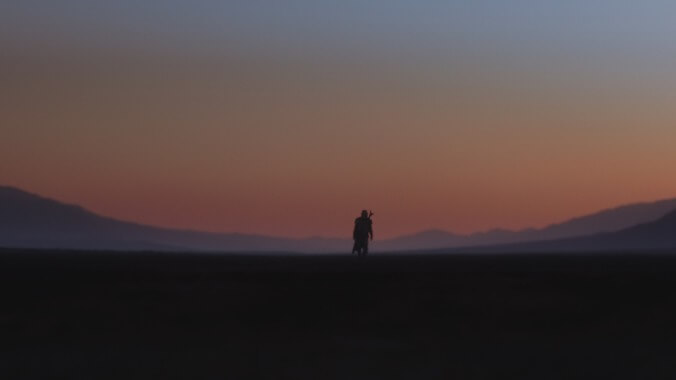Jawas are still a pain in the ass as The Mandalorian prepares for takeoff

A friend of mine joked on Twitter that The Mandalorian should be called “Lone Wolf and Yoda” after the big reveal at the end of episode one, and, in this episode at least, she was right. “The Child” opens with The Mandalorian (Pedro Pascal) walking through a desert canyon with the baby Yoda-type alien he declined to kill at the end of the premiere by his side, floating along in the Star Wars equivalent of Daigoro’s baby cart from the Lone Wolf And Cub series. Of course, this being Disney+, where all content is capped at a PG-13, our wrinkly little green friend’s space pram doesn’t spray bullets that hit their targets accompanied by spurting hoses of red tempera paint. But like its Japanese equivalent, “The Child” is committed to its guardian—a commitment that introduces the Force to this corner of the galaxy.
The scene where the adorable lil’ frog-swallower lifts the Mudhorn that’s about to gore The Mandalorian up in the air, throwing the creature off long enough for Mando to deliver a killing blow with his knife, is interesting on a few levels. First, it establishes why the 50-year-old baby is so valuable: Its Force powers are incredibly advanced for its young age. But it’s also interesting that The Mandalorian, and later Kuiil (Nick Nolte), are confounded by The Child’s actions, suggesting that the Force is not something that the average human (or alien) in this faraway corner of the galaxy even knows exists. Even though the Republic has been restored, the Jedi are still a thing of the past—for now, anyway.
Mystical forces aside, this was a really lively, fun episode, with some excellent action direction by Dope’s Rick Famuyiwa, particularly in the Indiana Jones-esque scene where Mando tries to stop a Jawa sandcrawler from taking off with everything but the walls of his ship. (They also got some of the walls.) I was delighted by how much screen time the Jawas got in this episode—it’s more than they got in the original Star Wars: Episode IV—A New Hope—and enjoyed their sassy comebacks in Jawaese accompanied by raucous laughter, as well as their excitement after they finally get their hands on that “suuga” (a.k.a. the egg Mando risked his life to trade for the stolen parts of his ship). These mischievous little fuckers added this episode’s element of comedy; The Mandalorian himself barely spoke at all, and Kuiil, the only other speaking character we spend any amount of time with in this episode, isn’t much of a jokester. That being said, the wordless gag when Famuyiwa cuts to Kuiil’s cart loaded down with recovered Razor Crest parts was also very funny.
Adding humor, and a cute element in the form of “The Child,” to a series otherwise billed as gritty and adult is very Star Wars, as is the nobility with which Kuiil refuses payment for his help fixing the Razor Crest. He thanks The Mandalorian for restoring peace to his valley, presumably because it will no longer be overrun with bounty hunters trying to get their hands on The Client’s (Werner Herzog) prize. We’re only two episodes in, but thus far the show seems to be working within an adventure-of-the-week format with frequent side quests and pit stops along the way to its ultimate narrative destination. At the end of the episode, The Mandalorian and The Child take off from the dusty surface of Avala-7, Mando behind the controls and The Child just waking up from a restorative nap-coma. Where they land at the beginning of next week’s episode will reveal much about Mando’s intentions, as well as where the story will go from here.
Stray observations
- The Mandalorian disintegrating his enemies in a puff of dust is not only a handy way for Disney+ to bypass R-rated bloodshed, it’s a callback to a scene in The Empire Strikes Back where Darth Vader points to Boba Fett and warns him, “no disintegrations,” thus establishing said method as a Mandalorian signature.
- And the weapon itself, known as an Amban phase-pulse blaster, has an even deeper origin: Boba Fett carries one in the animated segment “The Story Of The Faithful Wookiee” in the Star Wars Holiday Special.
- “I’m a Mandalorian. Weapons are part of my religion.”
- It’s been brought to my attention that “The Child” is a Yoda, but couldn’t be the Yoda reincarnated, as I speculated at the end of my recap for the first episode. According to the bounty on its head, “The Child” has been alive for 50 years, and The Mandalorian takes place five years after the events of The Return Of The Jedi. That means Yoda’s been dead for five years, six years max.
- Pedro Pascal also appears to have revealed The Mandalorian’s real name in a recent interview, where he refers to the character as what our sister site i09 transcribes as “Dyn Jarrin.”
- More Django vibes this episode, in the form of mud. Everyone in Django movies is always knee-deep in mud, and the mud caked all over Mando’s armor at the end of his knock-down fight with the Mudhorn is classic Corbucci.
- Contrast that with the gorgeous pink-and-blue sunset in the header image for this review, which is more of a Leone composition—and was also edited to remove the arguable spoiler of the baby Yoda’s egg-pram, which floats next to Mando in the same shot in the episode.
- This episode’s drinking game: every time Kuiil says “I have spoken,” take a shot.
- This episode is even shorter than the first at 32 minutes, and even more streamlined in terms of plot and dialogue. The tradeoff, as with “Chapter One,” is we get lots of atmosphere and callbacks instead—which I, for one, am fine with.
- Herzog calls baby Yoda “heartbreakingly beautiful,” which tracks.